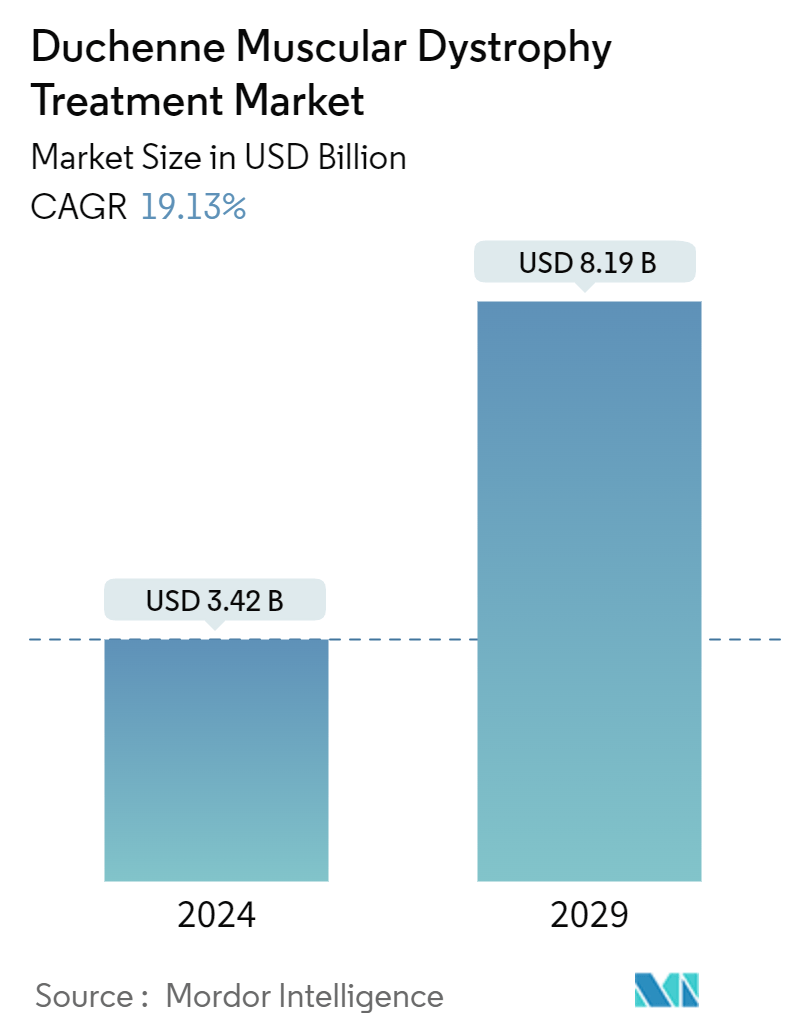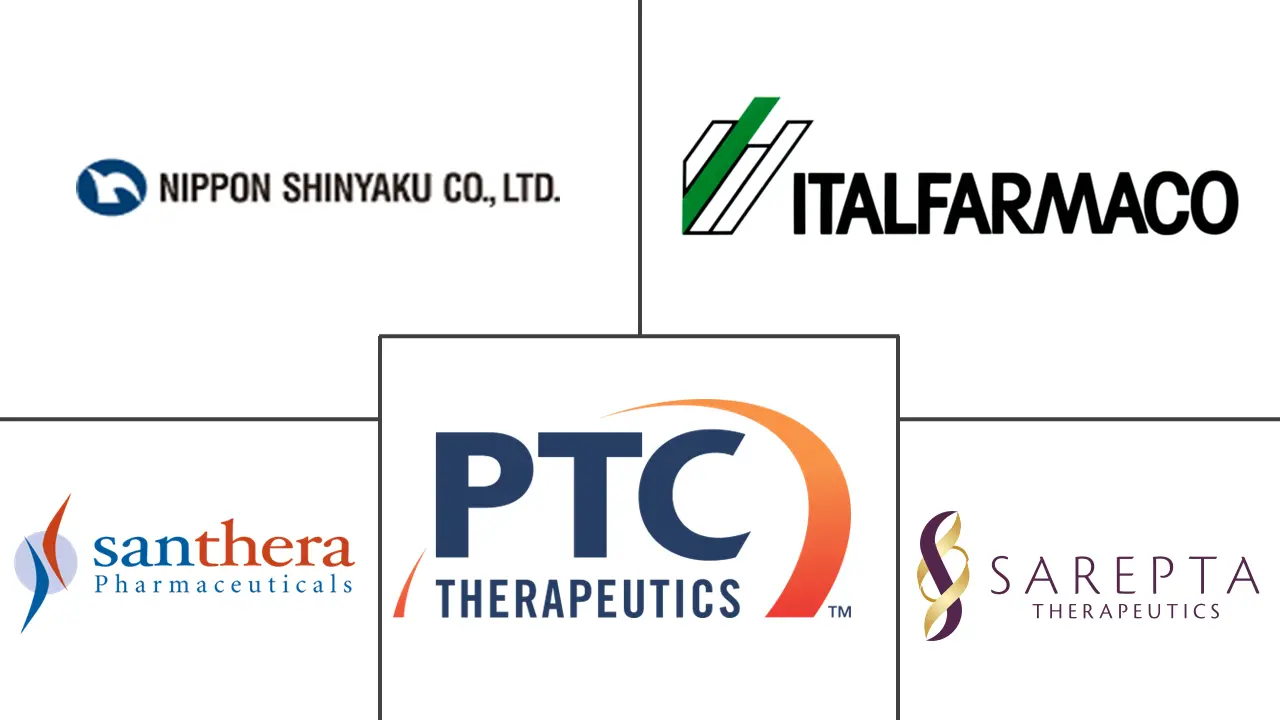Market Size of Duchenne Muscular Dystrophy Treatment Industry

| Study Period | 2021 - 2029 |
| Market Size (2024) | USD 3.42 Billion |
| Market Size (2029) | USD 8.19 Billion |
| CAGR (2024 - 2029) | 19.13 % |
| Fastest Growing Market | Asia Pacific |
| Largest Market | North America |
Major Players
*Disclaimer: Major Players sorted in no particular order |
Duchenne Muscular Dystrophy Treatment Market Analysis
The Duchenne Muscular Dystrophy Treatment Market size is estimated at USD 3.42 billion in 2024, and is expected to reach USD 8.19 billion by 2029, growing at a CAGR of 19.13% during the forecast period (2024-2029).
The rising burden of Duchenne muscular dystrophy (DMD), increasing investments in the R&D of novel therapies for DMD, and increasing awareness campaigns for DMD are the major drivers for the market. For instance, according to the data published by Muscular Dystrophy Association Inc. in June 2023, the prevalence of DMD in Europe and North America is approximately 6 per 100,000 individuals. According to a study published in the PLOS One Journal in June 2023, the prevalence of DMD within the general populace ranges from 1.7 to 3.4 cases per 100,000 individuals. Additionally, the birth prevalence of DMD stands at 21.7-28.2 cases per 100,000 live male births. These statistics provide valuable insights for healthcare professionals and stakeholders involved in managing and treating DMD, facilitating a better understanding of the condition's impact and informing strategic decision-making in healthcare provision and resource allocation. Thus, the high burden of this rare genetic disease is expected to boost the demand for its effective therapy, thereby boosting market growth.
Increasing investments in R&D by the private and public sectors have also increased the number of clinical trials evaluating potential DMD treatments. The approved pharmacological therapies for managing DMD are based on exon skipping therapies, mutation suppressing therapies, gene therapies, and corticosteroids, among others. In recent years, there has been a significant increase in the discovery and development of pharmaceutical drugs. Nearly all major companies are now focusing on R&D, which is likely to impact the market significantly in the coming years. For instance, in January 2023, Parent Project Muscular Dystrophy (PPMD) disclosed a strategic investment of USD 500,000 in Myosana Therapeutics Inc. (Myosana) to bolster the advancement and implementation of its non-viral gene therapy delivery platform. This initiative is geared toward mitigating skeletal muscle degeneration and addressing heart failure associated with DMD. Thus, increasing cases of DMD and rising investments in research and development are expected to propel the demand for the treatment, which may positively impact the market's growth.
Mutation-specific therapies may become a breakthrough in treating DMD. Additionally, there has been an increase in the number of campaigns to raise awareness of DMD, the development of mutation-specific therapies, the prevalence of the disease, the number of products in development, and the introduction of therapies like Exondys51 and Translarna, as well as corticosteroid-based anti-inflammatory drugs. The advancement of innovative pharmaceuticals and therapies, including disease-modifying treatments, substantial investment from multiple firms in drug research, and advocacy efforts from patient groups influencing regulatory approval processes, are primary catalysts propelling the Duchenne muscular dystrophy treatment market.
However, the lack of standardization to measure clinical efficacy across all stages of DMD may hinder the market’s growth over the forecast period.
Duchenne Muscular Dystrophy Treatment Industry Segmentation
As per the scope of this report, Duchenne muscular dystrophy is a rare genetic disease that causes gradual muscle wasting and weakness, brought on by the X-linked recessive pattern, which causes muscle deterioration. However, it could also be a recent mutation or a parent-passed genetic characteristic. The Duchenne muscular dystrophy treatment market is segmented by therapeutic approaches and geography. By therapeutic approaches, the market is further segmented into molecule-based therapies, steroid therapy, and other therapeutic approaches. The report also covers the market sizes and forecasts for major countries across different regions. The market size is provided for each segment in terms of value (USD).
| By Therapeutic Approaches | ||||
| ||||
| Steroid Therapy | ||||
| Other Therapeutic Approaches |
| Geography | ||||||||
| ||||||||
| ||||||||
| Asia-Pacific | ||||||||
| Rest of the World |
Duchenne Muscular Dystrophy Treatment Market Size Summary
The Duchenne Muscular Dystrophy (DMD) treatment market is poised for substantial growth, driven by the increasing prevalence of the disease and heightened investments in research and development of novel therapies. The market is characterized by a surge in clinical trials and the development of innovative pharmaceutical drugs, including mutation-specific therapies and exon-skipping technologies. These advancements are supported by significant financial backing from both private and public sectors, aiming to address the high unmet medical needs associated with DMD. Awareness campaigns and strategic investments, such as those by Parent Project Muscular Dystrophy, are further propelling the market forward, as they facilitate the advancement of therapies designed to mitigate muscle degeneration and associated complications.
North America is expected to lead the market growth, bolstered by high healthcare expenditure, government initiatives, and a robust pipeline of therapeutic candidates. The region's market is experiencing a wave of new product innovations and regulatory approvals, such as the FDA's accelerated approval of ELEVIDYS, which underscores the region's pivotal role in the DMD treatment landscape. The market is moderately fragmented, with key players like Nippon Shinyaku Co. Ltd, ITALFARMACO SpA, and Sarepta Therapeutics Inc. dominating the scene. As the market evolves, the introduction of new therapies and the anticipated increase in treatment rates are set to reshape the competitive dynamics, potentially reducing the market share of existing therapies like corticosteroids.
Duchenne Muscular Dystrophy Treatment Market Size - Table of Contents
-
1. MARKET DYNAMICS
-
1.1 Market Overview
-
1.2 Market Drivers
-
1.2.1 Rising Disease Burden of Duchenne Muscular Dystrophy (DMD)
-
1.2.2 Increasing Investments in the R&D of Novel Therapies for DMD
-
1.2.3 Increasing Awareness Campaigns for DMD
-
-
1.3 Market Restraints
-
1.3.1 Lack of Standardization to Measure Clinical Efficacy Across All Stages of DMD
-
-
1.4 Porter's Five Forces Analysis
-
1.4.1 Bargaining Power of Buyers/Consumers
-
1.4.2 Bargaining Power of Suppliers
-
1.4.3 Threat of New Entrants
-
1.4.4 Threat of Substitute Products
-
1.4.5 Intensity of Competitive Rivalry
-
-
-
2. MARKET SEGMENTATION (Market Size by Value – USD)
-
2.1 By Therapeutic Approaches
-
2.1.1 Molecular-based Therapies
-
2.1.1.1 Mutation Suppression
-
2.1.1.2 Exon Skipping
-
-
2.1.2 Steroid Therapy
-
2.1.3 Other Therapeutic Approaches
-
-
2.2 Geography
-
2.2.1 North America
-
2.2.1.1 United States
-
2.2.1.2 Canada
-
2.2.1.3 Mexico
-
-
2.2.2 Europe
-
2.2.2.1 Germany
-
2.2.2.2 United Kingdom
-
2.2.2.3 France
-
2.2.2.4 Italy
-
2.2.2.5 Spain
-
2.2.2.6 Rest of Europe
-
-
2.2.3 Asia-Pacific
-
2.2.4 Rest of the World
-
-
Duchenne Muscular Dystrophy Treatment Market Size FAQs
How big is the Duchenne Muscular Dystrophy Treatment Market?
The Duchenne Muscular Dystrophy Treatment Market size is expected to reach USD 3.42 billion in 2024 and grow at a CAGR of 19.13% to reach USD 8.19 billion by 2029.
What is the current Duchenne Muscular Dystrophy Treatment Market size?
In 2024, the Duchenne Muscular Dystrophy Treatment Market size is expected to reach USD 3.42 billion.

